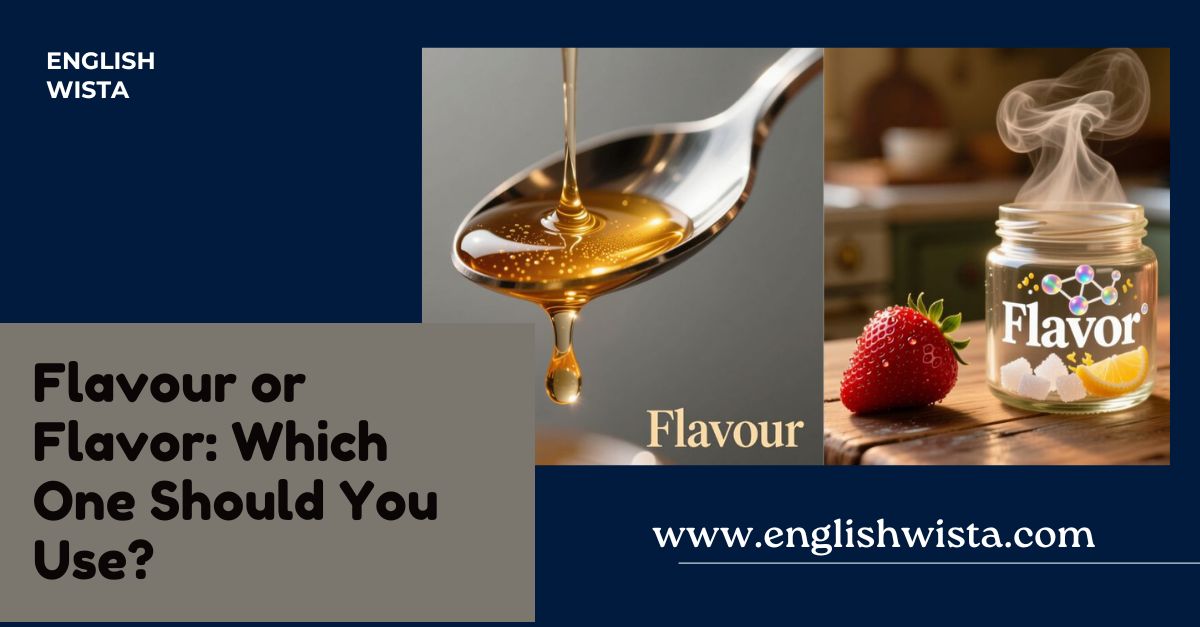Have you ever paused while typing and wondered, “Is it flavour or flavor?” You’re not alone. Many people bump into this exact question, especially if they’ve been exposed to both British and American English. It can feel a little confusing when you see two spellings of the same word floating around. But don’t worry you don’t need to scratch your head for long. The good news is that both spellings are correct, but they’re used in different parts of the world.
In this article, we’ll take a friendly walk through the differences between flavour and flavor. We’ll look at where each one is used, why the spellings are different, and how to choose the right one depending on your audience. We’ll also throw in some examples, fun facts, and clear explanations that make this easy to remember.
So, grab a cup of tea or coffee if you prefer and let’s dive in.
What Does “Flavour/Flavor” Mean?
Before we get into spelling, let’s nail down the meaning.
Flavour (or flavor) is a noun and sometimes a verb. It refers to the distinct taste of food or drink, often combined with smell.
- As a noun: It’s the specific taste of something.
- As a verb: It means to add taste to something.
Simple definition: Flavour/Flavor = the particular taste of food or drink.
Examples:
- “The ice cream has a rich chocolate flavour.”
- “What’s your favorite flavor of potato chips?”
- “She flavoured the soup with fresh herbs.”
Notice that the meaning doesn’t change at all, no matter which spelling you use. The only difference is where you are in the world.
Flavour vs. Flavor: The Core Difference
Here’s the quick and easy rule:
- Flavour = British English (used in the UK, Canada, Australia, New Zealand, South Africa, and other Commonwealth countries).
- Flavor = American English (used in the United States).
That’s it! The meaning is identical, but the spelling shifts depending on geography.
This difference comes from a long history of spelling changes, which we’ll explore next.
Why Are There Two Spellings? A Quick History Lesson
The double spelling traces back to the 18th and 19th centuries, when English spelling wasn’t as standardized as it is today.
Here’s what happened:
- British English kept many French-influenced spellings. The word flavour comes from the Old French flavor and Latin flavor, meaning “smell” or “odour.” Over time, British English adopted spellings with an extra -our ending, like colour, honour, and neighbour.
- American English simplified spellings. Noah Webster, an American lexicographer, wanted to make English easier and more logical. He dropped the u in many words, so flavour became flavor, colour became color, and so on.
The result? Two equally correct versions of the same word, depending on which form of English you’re writing in.
Is One Spelling More Correct?
Not at all! Both spellings are correct.
The key is consistency. If you’re writing for an American audience, use flavor. If your audience is in the UK or Commonwealth countries, go with flavour. Mixing them can confuse readers and look sloppy.
Example:
- Wrong: “My favorite ice cream flavour is vanilla.”
- Right (American English): “My favorite ice cream flavor is vanilla.”
- Right (British English): “My favourite ice cream flavour is vanilla.”
Notice that the difference often affects more than one word in a sentence. American English uses favorite and flavor, while British English uses favourite and flavour.
Other Words with the Same Pattern
Flavour vs. flavor is not an isolated case. There are several word pairs that follow the same -our vs. -or pattern.
Examples:
- Colour (UK) vs. Color (US)
- Honour (UK) vs. Honor (US)
- Neighbour (UK) vs. Neighbor (US)
- Labour (UK) vs. Labor (US)
If you remember one, you’ll easily spot the others.
Real-Life Examples in Sentences
Let’s see how the word is used in both British and American English:
British English (flavour):
- “This cake has a unique lemon flavour.”
- “He prefers crisps with a barbecue flavour.”
- “The chef is known for combining unexpected flavours.”
American English (flavor):
- “That soda has a new cherry flavor.”
- “She bought three flavors of ice cream for the party.”
- “Spices flavor the dish beautifully.”
As you can see, the word works in the same way in both versions. The only visible difference is the spelling.
Is Flavour/Flavor Singular or Plural?
Good question!
- Singular: flavour/flavor
- Plural: flavours/flavors
Examples:
- “Vanilla is my favourite flavour.” (singular, British)
- “Chocolate and strawberry are popular flavors.” (plural, American)
Simple and straightforward the plural just adds an s at the end, regardless of spelling.
Flavour as a Verb
Many people only think of flavour/flavor as a noun. But it can also be used as a verb, meaning to add taste.
Examples:
- British English: “She flavoured the bread with garlic.”
- American English: “He flavored the soup with herbs.”
Again, the meaning is identical, but the spelling follows the region.
Idioms and Expressions with Flavour/Flavor
The word also pops up in expressions and figurative speech.
Common phrases:
- “Add flavour to something” – Make it more interesting.
- “Her storytelling added flavour to the meeting.”
- “Flavour of the month” – Something or someone popular for a short time.
- “That new app is just the flavour of the month.”
- “Variety is the spice of life” – While not using the word directly, it’s related to the idea of flavour adding interest.
Fun Facts About Flavour/Flavor
- Taste + Smell = Flavour
Most of what we call “flavour” is actually smell. If you block your nose while eating, food tastes bland. - Science of Flavour
There’s a whole field called “flavour science,” which studies how taste, aroma, and even texture combine to create the eating experience. - Different Meanings in Tech
In computing, “flavor” sometimes refers to a version or variety of a software product. Example: “This Linux flavor is lightweight.” In these cases, the American spelling is more common.
Tips for Remembering Which to Use
If you struggle to remember whether to write flavour or flavor, here are a few tricks:
- Think of your audience. Americans expect flavor; Brits and Commonwealth readers expect flavour.
- Remember the “u.” British English often keeps the “u” in words like colour, neighbour, and flavour. American English drops it.
- Consistency matters. Stick with one system throughout your writing. Mixing spellings looks careless.
Quick Recap
- Both flavour and flavor mean the same thing: the distinct taste of something.
- Flavour = British English.
- Flavor = American English.
- Neither spelling is “wrong.” The right choice depends on your audience.
- The plural is flavours/flavors.
- It can also be a verb: “to flavour/flavor food.”
- Always stay consistent in your writing.
Conclusion
So, is it flavour or flavor? The answer is simple: both are correct. The difference is all about location and audience. If you’re in the UK, Canada, or Australia, you’ll see flavour. If you’re in the United States, you’ll see flavor.
The word itself hasn’t changed it still describes the taste and smell that make food enjoyable. What has changed is the spelling tradition. Think of it like ice cream flavours: vanilla or chocolate, both delicious, just slightly different.
Next time you’re writing, remember who you’re writing for, pick the spelling that matches, and stick with it. That way, your writing will look polished, clear, and correct.
So, whether you say “flavour” or “flavor,” you can be sure you’re choosing the right word as long as you stay consistent. And now, you can enjoy your next meal with a little extra appreciation for the flavour…or should I say, flavor…of words themselves.



